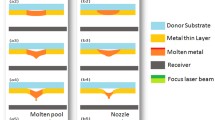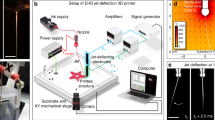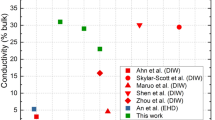Abstract
We have developed an ink-jet system which allows arrangements of dots with a submicron minimum size. Using an ultra-fine silver paste, we achieved the direct print of metallic wires of only a few micrometers in width without any pre-patterning treatment of the substrate, hydrophobic/hydrophilic patterning, bank patterning etc. We also propose an application, such as direct printing of ultra-fine redistribution wiring for a build-up board and/or package. Since all of these processes can be carried out at atmospheric pressure on the desktop without special treatment of the substrate. The direct fabrication process using ink-jet printing can be expected to be a powerful tool for both nanotechnology research and applications such as micro electronics, etc.







Similar content being viewed by others
References
Ago H (2003) Ink-jet printing of nanoparticle catalyst for site-selective carbon nanotube growth. Appl Phys Lett 82(5):811–813
Ago H, Qi J, Tsukagoshi K, Murata K, Ohshima S, Aoyagi Y, Yumura M (2003) Catalytic growth of carbon nanotubes and their patterning based on ink-jet and lithographic techniques. J Electroanal Chem 559:25–30
Gau H, Herminghaus S, Lents P, Lipowsky R (1999) Liquid morphologies on structured surfaces: from microchannels to microchips. Science 283:46–49
Hebner R, Wu CC, Marcy D, Lu MH, Sturm JC (1998) Ink-jet printing of doped polymers for organic light emitting devices. Appl Phys Lett 72:519–521
Heinzel J, Hertz CH (1985) Ink-jet printing. Adv Electron Electron Phys 65:91–171
Matsumoto J, Kawahara M, Shape identification for fluid-structure interaction problem using improved bubble element. IJCFD 15:33–45
Matsumoto J, Suzuki T, Tezuka A (2003) Numerical analyses of free surface flow with the advanced VOF method using stabilized bubble function element. In: Proceedings of the seventh US national congress on computational mechanics, 2003
Murata K (2002) New ink-jet technology for the formation of ultra fine dots less than 1/1000 the size of currently achieved—it is possible to produce ultrafine wiring of a few microns in width on the desktop. AIST pressrelease, http://www.aist.go.jp/aist_e/new_research/20020401/20020401.html
Murata K Super-fine ink-jet printing for nanotechnology. In: Proceedings of the international conference on MEMS, Nano and Smart Systems (ICMENS’03), Harima Chemical Inc., The details of the NanoPaste http://www.harima.co.jp/products/electronics/e_series_frame.html
Shirringhaus H, Kawase T, Friend RH, Shimoda T, Inbasekaran M, Wu W, Woo EP (2000) High-resolution inkjet printing of all-polymer transistor circuits. Science 290:2123–2126
Matsuba Y (2003) Direct patterning using metal nano-particles. J Jpn Inst Electron Packaging 6(2):130–135
Acknowledgements
The author gratefully acknowledge Dr. T. Iijima at AIST for the preparation of sol-gel solution of ceramics, D. Ito, M. Ueda, Dr. N. Hata and K. Oyama in Harima Chemical Inc. for the supply of silver NanoPasteTM and Mrs. H. Sagisaka in AIST for experimental assistance.
Author information
Authors and Affiliations
Corresponding author
Rights and permissions
About this article
Cite this article
Murata, K., Matsumoto, J., Tezuka, A. et al. Super-fine ink-jet printing: toward the minimal manufacturing system. Microsyst Technol 12, 2–7 (2005). https://doi.org/10.1007/s00542-005-0023-9
Received:
Accepted:
Published:
Issue Date:
DOI: https://doi.org/10.1007/s00542-005-0023-9




